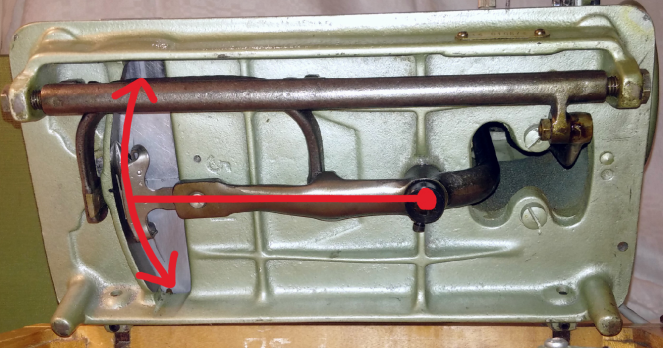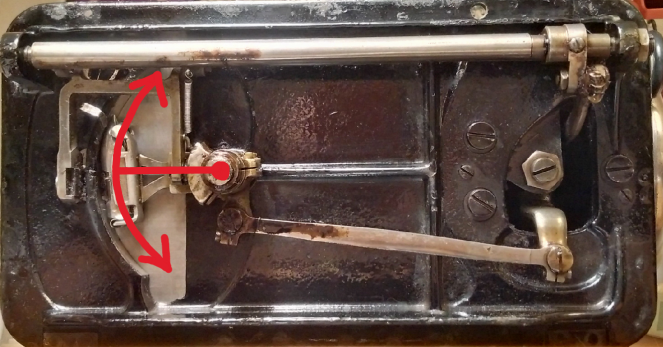Vibrating shuttle mechanism is the one with the bullet-shaped shuttle moving in an arc. There are three major types: one introduced by Singer, another by New Home and the third one by White. They are all called “VS” which is very confusing. In England, Jones used the White patent and called their White-based machines “CS”, or cylinder shuttle, no doubt in order to differentiate from Singer’s VS. In Germany, various makers mostly followed the Singer design, but there were a few notable exceptions.
Machine sizes
Singer vibrating shuttle machines come in two sizes: full size with the bed length of 14″, and 3/4 size with a 12″ bed (measurements are approximate). In Europe, those two sizes were quite well standardised for all three VS designs, so machines of different makes would usually fit into the same cases and treadles. But it’s best to always check to be sure, because the machines made in the USA had very different dimensions, for example.
Singer called their full size machines VS2, 3/4 ones VS3. Jones called their full size machines Medium CS, 3/4 ones Family CS, CS-E (with an electrical motor), Popular (with a Saxonia-style hand-crank), D53 (with a square boxy body).
Full size vibrating shuttle machines of either design are fairly rare. 3/4 size ones are common and plentiful. Their harp space (the space under the arm) is similar to that in modern multi-stitch machines with a much larger bed length of 16″ or more, which is sufficient for most domestic use.
The looks on the outside
On the outside, the three designs look very similar: they all have a wide silver band on the bed of the machine perpendicular to the arm.
There is an exception to this rule: the Hengstenberg/Anker machine with the Wittler mechanism. This German design is a variant of Singer’s VS with the shuttle swinging parallel to the arm of the machine, and so its silver band is shorter and runs along the bed of the machine rather than across it.

The difference inside
Flip back the machine and have a look at the mechanism inside the base – this is where they differ.
The White and Jones machines have a long arm that swings in a shallow arc, and the rotation centre is quite far to the right.

The New Home design has a medium-sized arm with a rotation centre pretty much in the middle of the bed. This example is by Mundlos who followed the New Home design with their vibrating shuttle machines.

The Singer and many German machines also have a long arm running along the bed, but it does not swing. The swinging arm is very short, the arc is steep and the rotation centre is on the left.

The Wittler variant is similar but the swinging arm is rotated by 90 degrees.

The shuttles
Because the shuttle must mirror the shape of the arc it is following, the difference in arc curvature makes for different slant of the tip of the shuttle. Short arm designs like Singer can keep the same shuttle for full size and 3/4 size machines because they can keep the arc the same and just lengthen the driving bar. However, in the medium and long arm designs the length of vibrating arm depends on the size of the machine bed, and so the arc is different in full size and 3/4 size models, which in turn means that each machine size has its own shuttle with a different curvature. Here is a side-by-side comparison of a Singer shuttle and a Jones Family CS shuttle – the difference in curvature is quite striking.
The bobbins
The bobbins for the original Singer, New Home and White machines are, of course, completely incompatible with each other. But in Europe Singer design dominated, so British and German manufacturers largely adopted Singer bobbin design for all their VS machines, except Pfaff who had their own hollow bobbins for a time, but they switched later. So European VS bobbins became interchangeable except for a little hole for a positioning pin in the bobbin winder. Singer machines don’t have such a pin, and their bobbins don’t have the hole. However, most other VS machines do have the pin, and so need that hole in their bobbins.
Since the hole does not interfere with the fit of the bobbin in the shuttle, I personally prefer the bobbins with the hole so they could be used in all vibrating shuttle machines.
Both bobbin types are being made again, so you are no longer restricted to chasing vintage ones. Just look for Singer 27/28 bobbins, and check for the hole.
It is worth noting that the Singer bobbins have a short pointy pip at either end which fits perfectly into the Singer bobbin winder, providing a good grip on the bobbin so that a positioning pin is not required to keep it in place. Non-Singer bobbins, old and new, don’t have appropriately shaped pips, so Singer bobbin winders might slip on them. There is however a very simple solution to this problem: a little BlueTack in the bobbin winder to hold the bobbin in place.
Needles
Needle types used by these machines depend on the make, but compared to other sewing machine mechanisms, vibrating shuttle often requires needles with a larger eye, which usually means thicker needles. So if your machine is skipping stitches, try a thicker needle, or a top stitch needle that has a larger eye than a regular one.
Singer VS machines take “standard domestic” needles, that’s type 15×1, a.k.a. 2020, HAx1 or 130/705H. They come in many varieties, including “top stitch” which have a larger eye. Most German machines of any VS design also use 15×1 needles, making them more usable today than the original White or New Home machines that used their own needles – impossible to find today.
Jones CS machines come in two variants: some take 15×1 needles, while others take “Jones” needles, that’s type 128×1, available for industrial sewing machines. But you can also often use a more common substitute: industrial needles DBx1 from Schmetz. Make sure they are from Schmetz rather than Organ because the shank on Organ needles is thinner which is enough to make it skip stitches. The shank is the thick bit at the top of a needle that goes into the needle clamp.




Just to check (because I’ve only used my Singer to make two items so far and I just used the needle that was already in there), are ‘standard domestic’ needles the same as generic ‘machine needles’ like the ones you can find in haberdashery shops and places like Hobbycraft? I ask as my local shops stock Hemline needles and don’t seem to have the numbers you mentioned on the packets.
LikeLike
Hi, yes – these are the common domestic sewing machine needles. They go by many names, and sometimes it just says “standard” or some such. By far the most domestic machines use these needles now-a-days.
LikeLike
Excellent. Thank you. 🙂
LikeLike
You’re very knowledgeable; thanks for sharing! I didn’t know that about thicker needles with larger eyes to avoid skipped stitches. Little details like that can make the difference between success and a whole lot of frustration.
LikeLike
Thank you, Jeanne! My knowledge is all hands-on, I had to find solutions for the problems I came across. And yes, the devil is as always in the details!
LikeLike
Help.
I have an old sewing machine that im unable to find any information on,
The name on the machine is Wabash.
Any information is much appreciated
Thanx
Simon.
LikeLike
Hello Simon, try asking at ISMACS – that’s ismacs.net. They have a mailing list that you could join – perhaps someone there can help you.
LikeLike
Wow! What a great site and explanation of shuttles and bobbins. I’m the proud new owner of a Domestic Number 3. (I’ve been restoring the machine for 3 weeks now.) I need to purchase a shuttle and a bobbin. Your experience and sharing is invaluable. Thank you!
LikeLike
It’s interesting that there doesn’t seem to be a counterweight on the other side of the VS shuttle arm’s pivot… I think that some or all TS machines have a counterweight on the bottom end of the vertical axle (underside of a TS looks so much like a piston engine! 🙂 ). Moreover, I’d swear I’ve seen a photograph of the underside of a German VS machine which did have a counterweight for the shuttle arm… but I can’t find it anymore. Have you perhaps seen a VS with a counterweight or do you think your machines without a counterweight could use one at medium and higher speeds?
In case of Jones CS, it seems the vertical swinging arm coming down through the tower could function as a counterweight.
LikeLike
Try Mündlos – there are pictures out there.
LikeLike
Hello Jana. I got no experience with these machines, but I have read about them the past week, and I have also been surprised not to see a counterweight at least for the short arm VS machines. It should reduce vibrations significantly. I looked at this Grizzner type R machine. It is produced from 1945-50 and therefore seems a late VS machine, but it got no counterweight.
https://www.naehmaschinenverzeichnis.de/verzeichnis-der-naehmaschinen/gritzner/
Perhaps these machines would not be able to sew faster anyway.
LikeLike
Mundlos has a counterweight. It is a VS after New Home design – with a medium arm. It does not make it faster though.
LikeLike
Ho my God… Thank you so much for sharing all your knowledge.
I am hoping to restore my grandmother’s Singer dating back 1904 !! But unless I can find a “belt” replacement and an instruction manual to even make sure I’m not missing any more parts….I won’t be able to make it.
Would you happen to know where I could find a belt, pretty please?
LikeLike
Is that a treadle belt or a motor belt? Both are available on eBay. If you know the model of your machine, you can download a manual from the Singer website (singer.com). Yes, also for old machines.
LikeLike
Thank you for sharing this information. I searched the local market for TS and VS machines, and quite many are for sale. I noted a quite late Gritzner machine Durlach model R. Its a short arm VS machine produced 1945-1950. I found information about it here: https://www.naehmaschinenverzeichnis.de/verzeichnis-der-naehmaschinen/gritzner/
It seems it also got some reputation for knit stretch stitching: “Es ist eine Geradstich-Nähmaschine mit Bogenschiffchen, und wenn Sie z.B. engmaschige, elastische Stoffe nähen möchten, bei denen andere Maschinen Stiche aussetzen, dann lässt diese Bogenschiffchen-Maschine sie nicht im Stich. Sie erledigt mühelos das, was andere Maschinen nicht können, in top Qualität”
LikeLike
I think what that text refers to is machines of other types. Every single VS machine that went through my hands, was able to make a flexible stitch for jersey. It’s a property of the mechanism rather than of a particular make. VS machines were produced well into 1960s.
LikeLike
Hi; I stumbled on this while trying to find some needle information for a VS machine I recently acquired with the intent to USE it. What I didn’t know then–but know now thanks to you!–is that White machines used their own brand of needles and you can’t find them any more. Is there a modern needle that makes an okay substitute that you know of?
The machine is gorgeous and in very good condition, in its original cabinet, with its manual, a box of accessory feet that may or may not go with it, and a half dozen bobbins. The serial number put it about 1895.
LikeLike